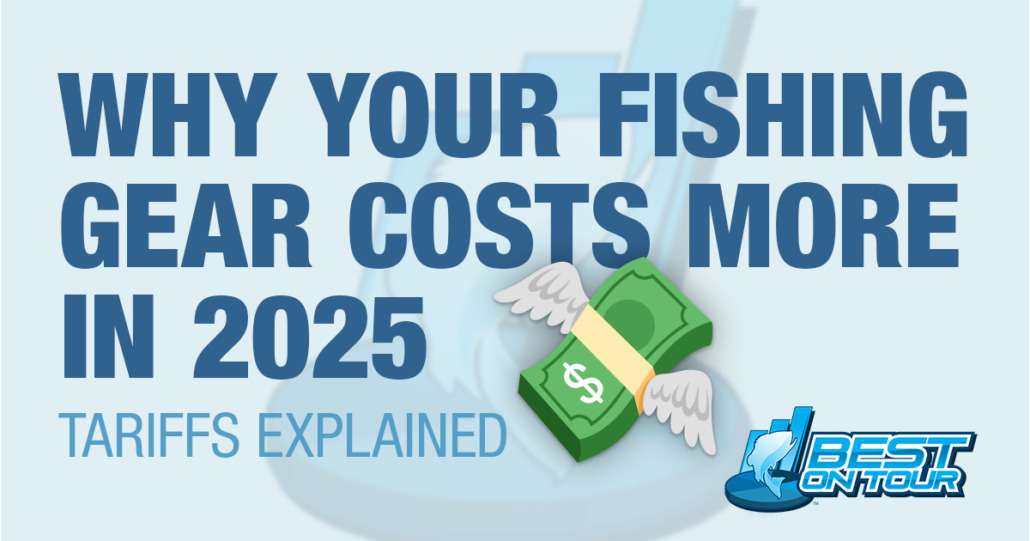
If you’ve noticed fishing tackle prices creeping up, you’re not alone — and it’s not just ordinary inflation. The bass fishing industry is being squeezed by a combination of tariffs, supply chain pressures, and long-standing taxes that few anglers even know exist. The result? Higher prices at the register, thinner margins for small tackle shops, and new challenges for companies that make the gear we all depend on.
Most Tackle Is Imported
According to the American Sportfishing Association (ASA), about 60% of fishing tackle sold in the U.S. is imported, and a large portion of that comes from China. That means our sport is deeply tied to international trade.
When the U.S. places tariffs on imported goods, fishing tackle is caught in the net. These tariffs aren’t paid by the foreign supplier — they’re paid by the U.S. company importing the product when it crosses the border. That cost is then passed down the line: wholesaler → retailer → angler.
So while tariffs are often framed as a penalty against foreign competitors, the immediate reality is that American companies and American consumers are footing most of the bill.
Even American-Made Brands Feel It
You might think “Buy American” solves the problem. And in the long run, tariffs do create an opening for U.S.-based manufacturers. But even gear made here at home isn’t insulated.
That’s because many domestic factories still rely on foreign-sourced parts, metals, or packaging. If those components get hit with tariffs, costs go up. Even for gear made entirely from U.S. materials, suppliers are raising their prices because they know imports are now more expensive.
One American fishing gear manufacturer told us their raw material suppliers raised prices by 23% in a single year. With imports off the table as a cheaper alternative, suppliers can “get away with it.”
Why Can’t We Just Build Everything Here
On paper, tariffs sound like a great way to encourage U.S. manufacturing. In reality, setting up large-scale tackle production here is anything but simple.
-
Building new factories takes years and millions of dollars.
-
Supply chains for parts and raw materials are already global.
-
Skilled labor and specialized equipment aren’t always available domestically.
This means most companies can’t simply flip a switch and start producing everything in the U.S. overnight. If that does happen in the long run, though, that will be a good thing!
The Hidden Tax Anglers Already Pay
There’s also a tax on fishing gear that predates today’s tariff topic — and many anglers have no idea it exists.
Since 1950, a 10% federal excise tax has been built into the price of rods, reels, lures, and other tackle. The same tax affects the archery industry. Unlike tariffs, though, this tax actually benefits anglers directly. The revenue goes directly into the Sport Fish Restoration Program, which funds fish stocking, habitat projects, boat ramps, and public access.
It’s one of the best examples of a “user pays, user benefits” system in the outdoors. But it still adds to the final price you see on the shelf.
Who Feels It the Most?
Small tackle shops are at the heart of the bass fishing community — and they’re the ones feeling this squeeze the hardest.
These shops already operate on thin margins. When wholesale prices jump 20–30% overnight, they either:
-
Raise prices and risk driving away customers, or
-
Absorb the costs and cut into their own livelihoods.
Meanwhile, anglers notice reels, rods, and lures climbing higher. A reel that cost $250 last year might be $300 this year — not because the shop is greedy, but because the entire chain of costs leading up to that sale has shifted.
The Bottom Line
Tariffs may help level the playing field for American manufacturers in the long run. But in the short term, they’re effectively a tax on U.S. companies and consumers.
For anglers, that means higher prices at the counter. For tackle shops, it means harder decisions about how to stay afloat.
The best thing we can do? Support your local tackle shop. Every purchase there helps keep the culture, the community, and the sport of bass fishing alive.
View this post on Instagram
If you like content like this,
Sign up for our once-a-week bass fishing industry newsletter FREE. Click here.
